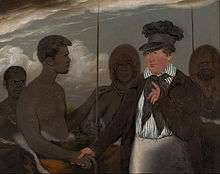George Augustus Robinson

George Augustus Robinson (22 March 1791 – 18 October 1866) was a builder and untrained preacher.[1] He was the Chief Protector of Aborigines in Port Phillip District (now Victoria, Australia), from 1839 to 1849. Prior to this appointment by the Colonial Office in Great Britain, he had been called upon to mount a "friendly mission" to find the 300 remaining Aboriginals in Tasmania.
Early life in England
Robinson was born on 22 March 1791, probably in London, England, to William Robinson, a builder, and Susannah née Perry. He followed his father into the building trade, married Maria Amelia Evans on 28 February 1814, and had five children over the next ten years. He decided to emigrate to the Australian colonies, and sailed for Hobart Town in Van Diemen's Land on the Triton, where he arrived in January 1824 and set up as a builder. His wife and five children joined him in April 1826.
Time in Van Diemen's Land (Tasmania)

Conflicts between settlers and Tasmanian Aborigines had vastly increased during the 1830s, which became known as the Black War. In 1830 Robinson investigated the Cape Grim massacre that had occurred in 1828 and reported that 30 Aborigines had been massacred. Robinson was to be brought in as a conciliator between settlers and Aborigines. His mission was to round up the Aborigines to resettle them at the camp of Wybalenna on Flinders Island.
Robinson befriended Truganini, to whom he promised food, housing and security on Flinders Island until the situation on the mainland had calmed down. With Truganini, Robinson succeeded in forging an agreement with the Big River and Oyster Bay peoples, and by the end of 1835, nearly all the Aboriginals had been relocated to the new settlement.
Robinson's involvement with the Tasmanian Aboriginals ended soon after this, though, and the Wybalenna settlement became more akin to a prison as the camp conditions deteriorated and many of the residents died of ill health and homesickness. Because of this, Robinson's place in history is generally viewed as negative, especially within the current Aboriginal community. Some historians agree that his initial intentions were genuine, but his abandonment of the community is viewed as a turning point for the worse for the Tasmanian Aboriginals. Moreover, his promises of providing a place where Aborigines could practice their cultural traditions and ceremonies never came to fruition.
Chief Protector of Aborigines in Port Phillip District
Robinson became Chief Protector of Aborigines in March 1839, managing the Protectorate of Port Phillip with the help of four Assistant Protectors, William Thomas, James Dredge, Edward Stone Parker and Charles Sievwright. Maria, Robinson's wife died in 1848.
Robinson was paid a total of £8000 in his role as protector of Aborigines. He built a small community that included a church and coined the area 'Point Civilisation'. Many of the Aborigines who lived at the port had been removed under false pretenses from their true home in Tasmania.[2]
In 1841 and 1842 Robinson traveled to western Victoria with Tunnerminnerwait where he investigated and reported on the Convincing Ground massacre that had occurred in 1833 or 1834.[3]
The Protectorate was abolished on 31 December 1849 and in 1852 he returned to England.
His journals are regarded as amongst the most important of early documents of the early years of Victoria, being significant for its observations on Koorie culture, early Melbourne personalities, landscape and settler society.
He was known as a 'Victorian do-gooder'.
Return to Europe
In 1853 Robinson married Rose Pyne, they spent the next few years living in Europe before returning to England in 1858. Robinson died on 18 October 1866 in Bath.
Semi-fictional accounts of Robinson's travels are included in Matthew Kneale's book English Passengers and in T. C. Boyle's short story "The Extinction Tales". There is a reference to Robinson in the book "The Lost Diamonds of Killiecrankie" by Gary Crew and Peter Gouldthorpe, and in Following the Equator, by Mark Twain.[4] Robert Drewes' 'Savage Crows' also incorporates the work of Robinson into the plot. See also Mudrooroo's critical portrayal of Robinson in Doctor Wooreddy's Prescription for Enduring the Ending of the World, Master of the Ghost Dreaming and his Vampire Trilogy: The Undying, Underground and The Promised Land.
References
- Serle, Percival (1949). "Robinson, George Augustus". Dictionary of Australian Biography. Sydney: Angus and Robertson. Retrieved 2008-10-13.
- Vivienne Rae-Ellis, Black Robinson Protector of Aborigines, Melbourne University Press, 1988 ISBN 0-522-84744-7
- ↑ "Robinson, George Augustus (1791–1866". Australian Dictionary of Biography. 2. Canberra: Australian National University. 1967. Retrieved 16 November 2014.
- ↑ BBC Four, Racism: A History, Part two of three, 'Fatal Impacts', Broadcast on Thursday 27 September 2007
- ↑ Ian D. Clark, pp17-22, Scars on the Landscape. A Register of Massacre sites in Western Victoria 1803-1859, Aboriginal Studies Press, 1995 ISBN 0-85575-281-5 Excerpt also published on Museum Victoria website, accessed 26 November 2008
- ↑ Mark Twain, (Samuel Clemons) (18 August 2006) [First published 1897]. "Chapter 27: Man is the Only Animal that Blushes. Or needs to.". In Widger, David. Following the Equator (txt or zip) (EBook #2895 ed.). Project Gutenberg. Retrieved 30 December 2009.
The Conciliator
- Lyndall Ryan, Tasmanian Aborigines: a history since 1803, Allen & Unwin, 2012 ISBN 978-1-74237-068-2 (esp. pp. 151-239)
External links
- George Augustus Robinson - State Library of NSW
- George Augustus Robinson - State Records of NSW
- the journals and papers of George Augustus Robinson (1791-1866) - NSW State Library Protector of Aborigines Heritage Collection
- Black Robinson: Protector of Aborigines. A controversial study of by Vivienne Rae-Ellis Melbourne University Press